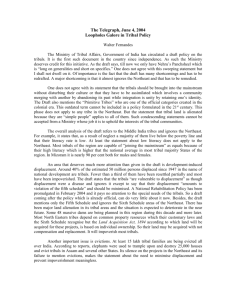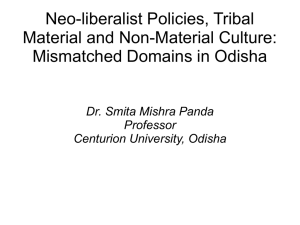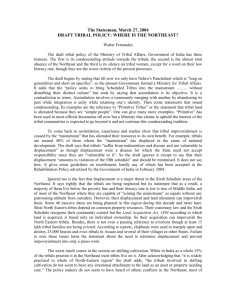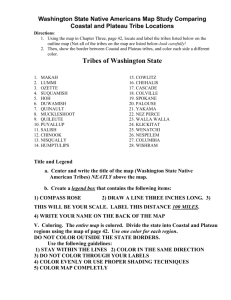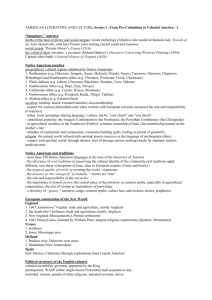the confict in the northeast: a historical perspective
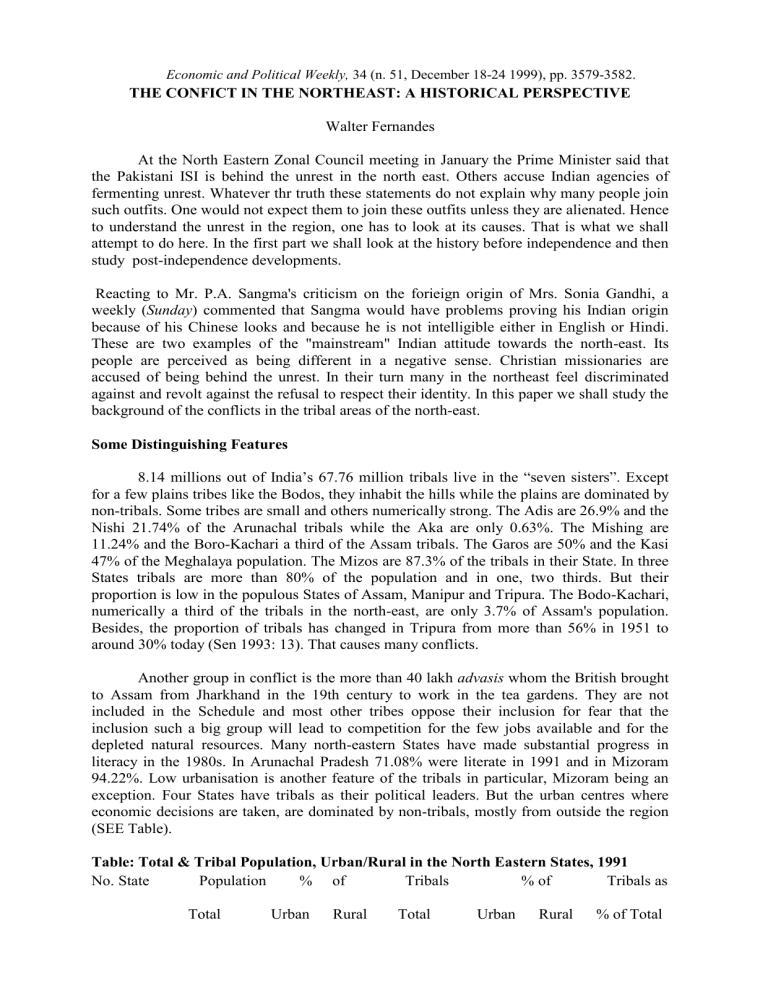
Economic and Political Weekly, 34 (n. 51, December 18-24 1999), pp. 3579-3582.
THE CONFICT IN THE NORTHEAST: A HISTORICAL PERSPECTIVE
Walter Fernandes
At the North Eastern Zonal Council meeting in January the Prime Minister said that the Pakistani ISI is behind the unrest in the north east. Others accuse Indian agencies of fermenting unrest. Whatever thr truth these statements do not explain why many people join such outfits. One would not expect them to join these outfits unless they are alienated. Hence to understand the unrest in the region, one has to look at its causes. That is what we shall attempt to do here. In the first part we shall look at the history before independence and then study post-independence developments.
Reacting to Mr. P.A. Sangma's criticism on the forieign origin of Mrs. Sonia Gandhi, a weekly ( Sunday ) commented that Sangma would have problems proving his Indian origin because of his Chinese looks and because he is not intelligible either in English or Hindi.
These are two examples of the "mainstream" Indian attitude towards the north-east. Its people are perceived as being different in a negative sense. Christian missionaries are accused of being behind the unrest. In their turn many in the northeast feel discriminated against and revolt against the refusal to respect their identity. In this paper we shall study the background of the conflicts in the tribal areas of the north-east.
Some Distinguishing Features
8.14 millions out of India’s 67.76 million tribals live in the “seven sisters”. Except for a few plains tribes like the Bodos, they inhabit the hills while the plains are dominated by non-tribals. Some tribes are small and others numerically strong. The Adis are 26.9% and the
Nishi 21.74% of the Arunachal tribals while the Aka are only 0.63%. The Mishing are
11.24% and the Boro-Kachari a third of the Assam tribals. The Garos are 50% and the Kasi
47% of the Meghalaya population. The Mizos are 87.3% of the tribals in their State. In three
States tribals are more than 80% of the population and in one, two thirds. But their proportion is low in the populous States of Assam, Manipur and Tripura. The Bodo-Kachari, numerically a third of the tribals in the north-east, are only 3.7% of Assam's population.
Besides, the proportion of tribals has changed in Tripura from more than 56% in 1951 to around 30% today (Sen 1993: 13). That causes many conflicts.
Another group in conflict is the more than 40 lakh advasis whom the British brought to Assam from Jharkhand in the 19th century to work in the tea gardens. They are not included in the Schedule and most other tribes oppose their inclusion for fear that the inclusion such a big group will lead to competition for the few jobs available and for the depleted natural resources. Many north-eastern States have made substantial progress in literacy in the 1980s. In Arunachal Pradesh 71.08% were literate in 1991 and in Mizoram
94.22%. Low urbanisation is another feature of the tribals in particular, Mizoram being an exception. Four States have tribals as their political leaders. But the urban centres where economic decisions are taken, are dominated by non-tribals, mostly from outside the region
(SEE Table).
Table: Total & Tribal Population, Urban/Rural in the North Eastern States, 1991
No. State Population % of Tribals % of Tribals as
Total Urban Rural Total Urban Rural % of Total
Arunachal 864558 12.80 87.50 550351 05.84 94.16 63.66
Assam 22441322 11.09 88.89 2874441 03.38 96.62 12.81
Manipur 1837149 27.52 72.48 632173 08.42 91.58 34.41
Meghalaya 1774778 18.60 81.40 1517927 13.56 86.44 85.53
Mizoram 689756 46.10 53.90 653565 45.21 54.79 94.75
Nagaland 1209546 17.21 82.79 1060822 12.04 87.96 87.70
Tripura 2757205 15.30 84.70 853345 01.65 98.35 30.95
Source: Registrar General and Census Commissioner 1992: 13-17.
Identity and Ethnicity
An offshoot of the population division is unequal power relations and conflict between the tribals and non-tribals as well as between various tribes. Their history shows that one cannot take an exclusive view of the conflict being religious or cultural or economic.
The effort to control the resources is basic to it. But it finds an expression in terms of nationality, identity and ethnicity. The tribals are not able to cope with the depletion of their resources caused by the commercialisation of forest and agricultural produce. They feel the need to come together to safeguard their livelihood or to take advantage of modernisation
(Roy Burman 1985: xii-xiii).
The ethnic consciousness that grows from this encounter with the dominant cultures leads to identity expansion or several groups merging to expand their identity without giving up their individuality. In this process they also develop a belief in a common origin as the
Naga and Mizo have done (Acharya 1990: 71-95). Apart from commercialisation of their resources, most struggles in the north-east are in reaction to the homogenising trend of the dominant “one State one nation” thinking of the Indian State and the tendency "to take the degreee of Aryanisation as the measure of Indianisation" (Datta 1990: 41). In attempting to turn itself into a nation, the Indian State does not respect the cultural and ethnic identity of different groups or recognise that the tribals have a culture and a religion of their own (Singh
1990: 234). The tribals react to the effort to homogenise cultures and monopolise their livelihood (Datta: 36-39). They also resent the domination of non-tribals, the Ahom in
Assam, the Meitei in Manipur and the Bengalis in Tripura. The sub-nationalism against the
Centre may lead to secessionist demands while resentment against the locally dominant groups takes the form of autonomy. Much of the history of the region is conditioned by this interaction.
Consequently the three steps of defending their livelihood, protecting their identity and propounding a sub-nationalism specific to a cultural and ethnic group merge into one.
But their expression depends on the nature of the leadership. When the traditional leaders provide the motive force for identity expansion they want to protect their resources as well as the traditional ways of using them. When an educated elite provides the leadership they demand control over them and a share in the benefits of the modern system (Roy Burman
1985: xiii-xiv). Secessionist demands usually come from the former and the struggles for autonomy are led by the latter.
Competition for Livelihood
The colonialist needed Assam mainly for its tea and later petroleum. The ensure control over them, the British dealt with each kingdom in a different manner. Common to the hill areas was the buffer zone concept against Burma and China. To ensure indirect control
over the region they modified and co-opted the control mechanisms. For example, the
Ahoms had the posa system i.e. compensation to the hill tribes in lieu of the dues they were entitled to in the territories they had conquered. The British continued it but hill tribes, particularly of Arunachal Pradesh and Nagaland, did not take kindly to them. They killed some of them when they went to to collect tribute. The British raided and punished the villages that committed these acts. The Ahoms had done the same earlier. The difference is that the British needed to popularise the finished products of the industrial revolution. To achieve it, they had to de-industrialise South Asia that had developed a manufacturing base.
In the north-east it took the form of destroying the tribal craft since it competed with the
Manchester textiles (Bose 1997: 197-201).
To give the example Nagaland, the first European who visited the kingdom of the
Angami, its dominant Naga tribe on January 18, 1832 met with resistance. But when the
Ahoms ceded to the British the territory bordering on their kingdom, thus providing a launching ground to attack the Naga territory, the Angamis reached a compromise with them and agreed to pay an annual tribute. When the sepoys and a British official went to collect it, the chiefs stated their inability to collect it from the people and killed them. The Naga chiefs who were defeated in the war that followed, were allowed to rule their own "unadministered" territory in return for tribute (Sanyu 1996: 88-106).
The Bodo-Kacharis are an example of British trade expansion resulting in tension with the neighbours. After the conquest of their land and of Arunachal Pradesh, the Udalguri mart, till then their main barter point, became an important trading centre. The Bodos were not very familiar with monetary transactions. So merchants from Tezpur, Barpetta and elsewhere took control of trade. The Barpetta traders come to control Bodo cultivation since much of the trade was in agricultural produce. It increased land alienation that had started after the Permanent Settlement 1793 and the 1834 Assam Land Act. Then came the move to settle Bengali peasants on “wasteland” which was their livelihood. 90% of them were
Muslims (Roy 1995: 24-31). These developments laid the foundation of Bodo enmity with the Ahoms on the one hand and Muslims on the other. Similarly, before the arrival of the
British, Manipur already had a Meitei dominated society. The colonialist depended on the traditionally dominant groups to control the masses. It has resulted in tribal-Meitei as well as
Naga-Kuki enmity (Ray 1990: 267-270).
Missionaries and Ethnic Identity
Much awakening resulted from this destabilisation and the process of their coming together began with it. Many Naga tribes had come together against the British. Missionary intervention at this time facilitated their ethnic identity expansion. Their conversion itself was an offshoot of their efforts to protect their identity. They had seen how the Meiteis and
Ahoms had been Sanskritised and were afraid of being subjected to the same homogenising process. That is when conversions to Christianity increased among them (Downs 1983: 6-8).
The missionaries probably did very little to protect their culture. But they provided the organisational structure they required to cope with the changes and to come together.
That conversions were a response to the changes is confirmed also by the fact that where an alternative was available that combined social reform with protection of identity, conversions to Christianity were relatively few. The Bodos, sandwiched between the British planters, Ahom traders and Bengali peasants, moved to the north where they faced competition from Nepali migrants. The lower bureaucracy in Assam was dominated by the
Ahoms and the higher level by the Bengalis. So they had none to defend their interests. They
saw themselves falling behind the Ahoms in education and being denied access to political and administrative power. The process of conversion because of their helplessness and the need to safeguard their resources had begun among the Bodos in Kokrajar. That is when their leader Kallicharan Brahma was converted to a Hindu sect that combined religious with social reforms (Roy 1995: 30-39).
To understand the missionariy’s role one has to debunk the myth of his close cooperation with the colonialist. Not being keen on their own involvement in this region, they alotted the area to American Baptists and Methodists while the British Presbyterians,
Anglicans and Methodists were allowed into the “mainland”. The difference in nationality and sects ensured cool relations between the two. Another point of tension was leadership.
The colonialist depended on the traditional chiefs while the missionary concentrated on education from which new leaders emerged. The chiefs opposed the missionary because conversion, the morality he preached and the new leaders were a threat to their power.
Conversion also began the process of bringing the warring tribes together and that was a threat to the colonialist who depended on division among them. So there was ongoing tension between the missionary and the British on the one hand and the chiefs and the missionary on the other. Though eventually the chiefs too converted, the difference in their approach persisted (Sen 1992: 37-40).
In attributing unrest to missionaries, it is forgotten that the ULFA leaders are almost exclusively Hindu, so are most Bodo leaders. Elsewhere the difference is between the traditional and modern leaders. By and large the traditional chiefs supported the British while the new leaders joined the freedom fighters because they viewed the State as a modern institution. But the two were united in their effort to protect their resources though their understanding of their use differed. But even while co-operating with the freedom fighter, the new leaders remained ambiguous because of their homogenising tendency. They felt that the freedom fighters did not understand their identity and that they were also excluded from the benefits of the British administration. The decisive moment was the Japanese invasion. .A.
Z. Phizo, a traditional chief succeeded in bringing 27 tribes together under one umbrella. To some extent it increased the power of the chiefs (Sanyu 1996: 115-126).
Tension, Awakening and Organisation
From the 1930s their desire to cope with the changes expressed itself in the form of new organisations. The Bodos emulated the Ahom institutions that had helped them to make advances in education. The Bodo Chhatra Sammilani and literary associations were formded in the 1930s for their education, welfare and to standardise their language. Land alienation and indebtedness were their major problems. The Notified Areas Act was amended in 1947 to prevent land alienation. But the situation did not improve because of malpractices.
Besides, the Constitution did not provide to the plains tribes the safeguards available to the hill tribes mainly because of the Assam Congress leader Gopinath Bordoloi's contention that they were being assimilated with the rest of the population. In reaction to these moves and because of the role of the Barpetta merchants, the Bodo cultivators came to view the Ahoms as the main enemy and take an anti-Assamese stand (Roy 1995: 41-57).
In 1918 the new leaders formed the Naga Club which soon assumed political dimensions and was renamed the Naga Hills District Council. The traditional chiefs changed it to the Naga National Council. The names are indicative of their thinking. The educated elite wanted an autonomous district while the traditional chiefs deamnded independence.
That was the time for negotiations. But the failure of the national leaders to understand their
aspirations seems to have alienated the Nagas and many other north-eastern tribes. The new elite would have been strengthened if the national leaders had discussed the basic issues confronting them. In 1987 Phizo wrote to Prime Minister Rajiv Gandi, that he had met the
Mahatma in 1946 and that he was ready to negotiate the status of the Naga Hills district. But the tendency of other leaders was towards homogenisation. So the chiefs declared independence on August 14, 1947 (Sanyu 1996: 131-134).
In the Lushai Hills (Mizoram), the creation of Burma divided the Chin tribes. The
Partition divided them again. So those who remained in India had to find a new identity. That is a major reason why conversions to Christianity began around 1907. Mizoram has a more or less homogeneous population, 94.75% being tribals, 87% of them Mizos. In 1946 their new leaders formed the Mizo Union that wanted the Lushai Hills to become an autonomous district within Assam. The traditional leaders who formed the United Mizo Freedom
Organisation (UMFO) demanded its merger with Burma. The former was affiliated to the
Congress and the latter merged with the Eastern India Tribal Union (EITU). In 1948 the
Mizo Union launched a campaign against the chiefs and captured all three Assembly seats in
1952. They lost one of them to EITU in 1957 and 1962. Thus the people too seemed to be behind those who wanted autonomy while safeguarding their identity. But the failure of the national leaders to understand them strengthened the chiefs. During the major famine of
1959 a chief Mr Laldenga who formed the Mizo National Famine Front got a large following. Later it became the Mizo National Front. The 1960 Assam language Act protected tribal languages only in the districts where they were spoken. Otherwise Assamese was to be the official State language. These and other issues resulted in the two Mizo Union MLAs resigning their seats after their election in 1962. The MNF demanded independence in 1963 and won both the seats (Sen 1992: 37-43).
In Tripura the main causes of the unrest are post-independence with their foundation laid earlier. In 1863 the Jamatia tribe revolted against the coolie labour system imposed on them. The Reangs started an anti-feudal movement in 1941-43 under the leadership of
Ratanmani. During World War II, the king tried to recruit them in the army but they refused.
They were arrested and brought to Agartala but fled to the Chittagong Hills. Till independence mostly Muslim Bengali peasants migrated to Tripura. But in 1946 a large number of Hindus flocked there because of communal riots in Mymensingh (Sen 1993: 30).
Most migrants since 1947 are Hindus from Bangladesh. The population of Tripura grew by
34.41% in 1971-1981 and 33.69% in 1981-1991. The tribals who were 70% of the population in 1901, came down to 56.37% in 1951 and are around 30% today. They have lost not merely their land but also access to education and other institutions. In 1961, 20.24% of the non-tribals were literate against 10.01 tribals. In 1981 the figures were 42.12% and
23.07% respectively (ibid: 14-18).
In Manipur the 29 tribes are divided into Naga and Chin with a few buffer groups wanting to join one or the other. They are a minority and the developmental process is controlled by the Meitei, a Sanskritised Mongoloid group. The main competition in recent decades between the tribals and the Meitei and between relatively strong tribes like the Naga and Kuki has been for land. Its monopolisation is a basic cause. For example, between the agricultural censuses of 1976-77 and 1980-81, the number of small and marginal farmers declined by 1.7% and the area they operated, by 3.03%. The medium and big farmers grew by 0.52% but land owned by them increased by 3.49%. The tribals being predominantly small and marginal farmers, were among the biggest losers. Another section of them was tenants. With personal cultivation becoming profitable, many landowners went out of the
market. So by 1980 only 3.49% of the land was leased against 14.9% in 1970 (Singh 1993:
33-34).
Thus the causes of unrest differed from tribe to tribe, but the process is similar. In some form or the other the conflicts arose as a reaction to a homogenising State. The educated elite wanted to be an integral part of India while retaining their identity and control over their livelihood. But the homogenising tendency made co-operation difficult. Another factor is internal divisions. With control over land, jobs and the economy in general passing into the hands of outsiders, competition began for the little that was left over. So in some cases the tribals have fought among themselves, for example the two factions of NSCN in
Nagaland, the Nagas and Kukis in Manipur and the Ahoms, Bodos and the adivasis .
Unimaginative Solutions
But the Government has attempted administrative solutions to the social and economic issues. At independence the feeling among the national leaders was that since the
British had separated the tribal areas of the north-east from the rest of the country, administration should be extended to them. In so doing, their specificity was all but ignored.
The leaders viewed reorganisation as the main solution. But the economy was transferred to the hands of outsiders (Choudhury 1990: 136-142). One is also left with the impression that after the Sino-Indian conflict of 1962, the concept of a buffer zone re-emerged. Its consequence is the law and order approach. Much of the north-east is under the Special
Armed Forces Act since 1958.
Nagaland is a good example. In the mid-1950s the inner line permit was modified to suit the needs of some economic forces. The leaders led by Phizo rose in revolt. They knew from their experience against the Japanese that many tribes can come together against a common enemy. The Centre seems to have reacted only in law and order terms and sent in the armed forces. It also facilitated the formation of the Naga People's Convention, an organisation formed by sections of a few tribes not much represented in the underground.
The militants were not represented when the Centre negotiated with this group and agreed to the formation of Nagaland in 1963. The large amounts of funds pumped into the State after it have resulted in corruption and division among the Nagas and in abuses such as class formation in their otherwise egalitarian society. But the problem has not been solved (Sanyu
1996: 135-138). Negotiations are continuing today with the main wing of NSCN but a smaller group is resisting. There seems to be a slow change of leadership but its extent is difficult to assess. One can also ask whether in the absence of a solution, even the new leaders have accepted the framework of the chiefs.
In Mizoram too, a consequence of the agitation was that it brought various Chin tribes under a single umbrella. Those who remained in India after the formation of Burma and later East Pakistan, came together to find a new Mizo identity. However, because of the tendency of Assam not to respect their culture, language and identity, the modern leaders turned against the State and kept demanding autonomy while the traditional leaders demanded independence. On 1st March 1966, Laldenga formed the underground government. Amid the rebellion that ensued, the Centre introduced the village regrouping scheme. The people were forced out of their ancestral villages, their houses destroyed and
464 villages regrouped into 109 centres between 1967 and 1970. The Mizo leaders approached the Guwahati High Court that issued a stay order on the centres. So regrouping was withdrawn in 1970. An amnesty offer was made which many rebels accepted. In 1972
Mizoram was turned into a union territory but the struggle continued. On December 31, 1974
the MNF issued "Quit Mizoram" notices to non-Mizos. An accord was signed during the
Emergency but rebellion erupted again in the mid-1980s. Finally an accord was signed on
30th June 1986. Mizoram became a State in 1987 and MNF won the elections (Sen 1992:
44-50). The growth in literacy, urbanisation and other developments indicate that the modern leadership has emerged after the accord. Homogeneity combined with their history of missionary involvement, insurrection and the consequent political awareness has made it possible for them to make progress.
All these years, the struggle against Assam was weaker than that against the Centre.
Despite an anti-Assamese feeling after the Assam Languages Act, Tripura and the Bodos joined the anti-foreigner movement in the 1970s and added their own demands such as their language as the medium of instruction. The All Bodo Students Union (ABSU) formed in
1967 slowly became a major political force. The movement for Udyanchal (Bodo and
Mishing State) began in the 1970s under the Plains Tribals Association of Assam. But division among its leaders brought in some radical ideas. The differences were submerged in the anti-foreigner movement.
However, the 1985 accord, Clause 6, spoke of protecting the cultural and social heritage of the Assamese but made no mention of the others. Clause 10 on preventing encroachments on government and tribal land caused more apprehension in their minds.
With that the demand for Bodoland grew under the Bodo People's Action Committee. An agitation was launched on March 2, 1987. An alliance too seems to have grown with NSCN.
The Bodoland Accord was signed in 1992 but the agitation continues partly because its implementation has been partial and partly because of division among the Bodos. At present it is mainly around the borders of the Bodo Autonomous Council. This creates a conflict both with the Ahoms and with the Adivasis (Roy 1995: 59-69).
Conclusion
The historical background shows on the one hand a conflict between the modern and traditional leaders and on the other between tribal autonomy and identity and the homogenising forces. In ensuring their control of the “unadministered” territories, the British encouraged the traditional leaders and came in conflict with the missionaries who concentrated on education and a modern elite. Both types of leaders wanted to protect their identity but in substantially different ways. The former wanted independence and the latter autonomy. But with their homogenising ideology, the national leaders viewed the problem from an exclusively law and order and administrative perspective. Their failure to recognise the real problems while searching for a solution have strengthened the traditional leaders. So the first step in finding a solution to the unrest is to understand their aspirations and respect their cultural, economic and social autonomy and identity.
References
Acharya, S.K. 1990. "Ethnic Processes in North-Eastern India," in D. Pakem (ed).
Nationality, Ethnicity and Cultural Identity in North-East India.
New Delhi: Omsons
Publications, Pp. 69-108.
Bose, M.L. 1997. A History of Arunachal Pradesh.
New Delhi: Concept Publishers.
Choudhury, J.K. 1990. "Post-Colonial Policy Towards Ethnic Minorities of North-East
India," in D. Pakem (ed). Op. Cit. pp. 127-145.
Datta, Brijendranath. 1990. "Ethnicity, Nationalism and Sub-Nationalism, With Special
Reference to North-East India." In D. Pakem (ed). Op. Cit. pp. 36-44.
Downs, Frederick. 1983. History of the Missions in North-Eastern India.
Delhi: ISPCK.
Ray, A.K. 1990. "Ethnicity: A Manipur Case." In D. Pakem (ed). Op. Cit. pp. 266-274.
Registrar General and Census Commissioner. 1992. Census of India 1991: Series 1, India:
Final Population Totals.
New Delhi: Controller of Publications.
Roy, Ajay. 1995. The Boro Imbroglio.
Guwahati: Spectrum Publishers.
Roy Burman, B.K. 1985. "Foreword" in Gangmumei Kabui.
Anal: A Transborder Tribe of
Manipur.
Delhi: Mittal publishers, pp. xi-xiv.
Sanyu, Visier. 1996. A History of Nagas and Nagaland: Dynamics of Tradition Village
Formation. New Delhi: Commonwealth Publishers.
Sen, Sipra. 1992. Tribes of Mizoram: Description, Ethnology and Bibliography.
New Delhi:
Gian Publishing Company.
Sen, Sipra. 1993. The Tribes of Tripura: Desription, Ethnology and Bibliography.
New
Delhi: Gian Publishers.
Singh, Ch. Priyaranjan. 1993. "Ithai Barrage: Development and the Tragedy of the
Unorganised Peasantry," in Gangmumei Kabui (ed). Ithai Barrage: Boon or Scourge for
Manipur?
Imphal: Ithai Barrage People's Organisation, pp. 32-36.
Singh, A.K.Ranjit. 1990. "Emergent Ethnic Processes in Manipur: A Reappraisal." In D.
Pakem (ed). Op. Cit. pp. 233-251.
